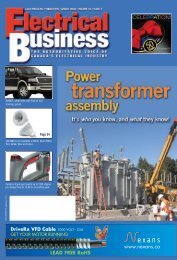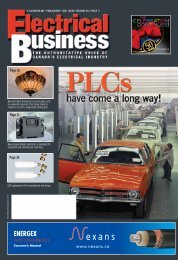Page 27 Page 32 Page 17 - Electrical Business Magazine
Page 27 Page 32 Page 17 - Electrical Business Magazine
Page 27 Page 32 Page 17 - Electrical Business Magazine
- No tags were found...
You also want an ePaper? Increase the reach of your titles
YUMPU automatically turns print PDFs into web optimized ePapers that Google loves.
CODE FILEBY KRIS PASZKOWIAK, P.ENG.Conductors over or near buildingsZero clearance lot line is a situation in which a buildingis set to the lot boundary, leaving very little spacebetween it and existing high-voltage conductors.Developers try to maximize the use of a lot, sometimesoverlooking the inherent electrical safety concerns arisingfrom inadequate clearances. Similarly, installing high-voltageconductors over or near buildings without the requiredhorizontal and vertical clearances can lead to electricalcontact fatalities.That said, figuring out what constitutes safe clearancedepends on applicable codes in your jurisdiction.For instance, the Ontario Building Code, Subsection3.1.18.1., states:Where a building is to be constructed in proximity toexisting above-ground electrical conductors of a voltagenot less than 2.5kV and not more than 46 kV,a) the building shall not be locatedbeneath the conductors, andb) the horizontal distance between the buildingand the conductors shall not be less than 3 m.It goes on to explain that where a building is to be constructedin proximity to existing above-ground electricalconductors of a voltage exceeding 46 kV, the clearancebetween it and the conductors shall conform to the requirementsof CAN/CSA-C22.3 No. 1, Overhead Systems.The Canadian <strong>Electrical</strong> Code (CEC) Rule 12-312,Conductors over Buildings, states that conductors shallnot be installed over buildings unless a deviation has beenallowed under Rule 2-030. However, CEC Section 36,High-Voltage Installations, amends the general requirementsof Section 12.CEC Rule 36-110, Guarding of Live Parts and ExposedConductors (and Table 33) specifies the required horizontalclearances—including protuberances—to be 3 m formaximum system voltage not exceeding 46 kV and 3.7 mfor 69 kV.For vertical ground clearances, you must refer to Table34. For voltages exceeding 69 kV, CEC also requires clearancesto be in accordance with CAN/CSA-C22.3 No. 1.There’s an additional requirement in CEC Rule 310 (3)pertaining to high-voltage power lines spanning over 50m: the vertical ground clearances specified in Table 34must be increased by 1% of the amount by which the spanexceeds 50 m.A key point of interest is the note in CEC Appendix B,which states that the spacing and clearances shown in Tables33 and 34 differ intentionally from those found in CAN/CSA-C22.3 No. 1. The note explains that the stated clearancesfor wires and conductors are minimum values related tomaximum specified loads and service conditions, representingdesign limits rather than clearances for construction or dailyoperation. “Clearances provided at the time of construction,”it goes on to say, “under ambient conditions then prevailing,must by design be sufficiently greater than the statedminimum clearances to ensure that actual clearances that willresult under the maximum specified loads, and service conditionswill not be less the stated minimum clearances.”Essentially, CEC rules apply at the time of installation whileCAN/CSA-C22.3 No. 1 applies at the time of system design.The code, as well as CAN/CSA-C22.3 No. 1, prefer not topermit high-voltage power conductors over buildings whenthere’s a suitable alternative. When there is none, then additionalmeasures must be taken to ensure the safety of thosewho will be working on or near the building. (In Ontario,this option only applies to installations over 46 kV.)Common solutions to clearance problems include relocatingthe line, increasing clearances or going underground.Correcting these issues once a building is completed (ornear completion) can be both difficult and expensive,which is why effective communication with your municipalbuilding department prior to construction is the key toavoiding these additional costs. The alternative of ignoringthe situation is unacceptable, as it can lead to injury ordeath from electrocution.Kris Paszkowiak, P.Eng., has taken his many years of experience—mostof those with Ontario Hydro and the <strong>Electrical</strong> SafetyAuthority—and launched CodeSafety Associates, a new consultingfirm serving the needs of the electrical industry. He holds aMaster Electrician licence and has served numerous organizationsover the years, including the Canadian Advisory Councilon <strong>Electrical</strong> Safety, Committee on CEC Part I and UL <strong>Electrical</strong>Council. Contact CodeSafety Associates at (905) 599-<strong>27</strong>02 orkris.paszkowiak@gmail.com.Questions and answerscompiled by ESATackle theCode Conundrum...if you dareSo, you think you know the electrical code, eh? Well, we’ll soonfind out if you’re an electrical code junkie or downright codeclueless.Take a look at the following questions and check youranswers in January's <strong>Electrical</strong> <strong>Business</strong>.How did you do?3 of 3 – Not only are you smart, you love to show off.1 of 3 – Your understanding of these questions is not up to code.2 of 3 – You’re pretty smart, but you still missed one.0 of 3 – Did you come up with your answers by playing Eenie,Meenie, Minie, Moe?Question 1Non-current-carrying parts of tube stands, tablesand other apparatus in an installation of diagnosticimaging installations shall not be bonded to ground.a) True b) FalseQuestion 2All metal raceways and all non-current-carryingmetal portions of fixed or portable equipment used infinishing processes—regardless of voltage—shallbe bonded to ground in accordance with Section 10.a) True b) FalseQuestion 335 (1-1/4) rigid PVC conduit shall be securelyattached to hangers or to a solid surface with themaximum spacing of the points of supports notgreater than:a) 750 mm c) 1.5 mb) 1.2 m d) 1.8 mAnswersto Code Conundrum<strong>Electrical</strong> <strong>Business</strong> October 2007▼▼▼Q-1: Electric vehicle charging equipment rated at ___ or more shallbe supplied by a separate branch circuit that supplies no other loadsexcept ventilation equipment intended for use with the electric vehiclesupply equipment.b) 20 amp. Rule 86-300.Q-2: Wiring of an essential electrical system in a patient care area shallbe permitted to occupy the same raceway as non-essential wiring.b) False. Rule 24-302(3) which states: (3) The wiring of the essentialelectrical system shall be kept entirely independent of all other wiring andequipment and shall not enter a fixture, raceway, box or cabinet occupiedby other wiring except where necessary... (a) in transfer switches; and (b)in emergency lighting fixtures supplied from two sources.Q-3: All receptacles that are part of an essential electrical system in apatient care area shall be what colour?Red. Rule 24-106(7), Receptacles in basic care areas, which states: (6)All receptacles that are part of an essential electrical system shall becoloured red, and no other receptacles shall be so coloured.CSA_banner_EB_Nov07.indd 1To find out more, register to receive CSA’s “Keep Me Informed” e-newsletterINFO NO. 5611/23/07 12:06:47 PM38 • NOVEMBER/DECEMBER 2007 • www. mag.com
















